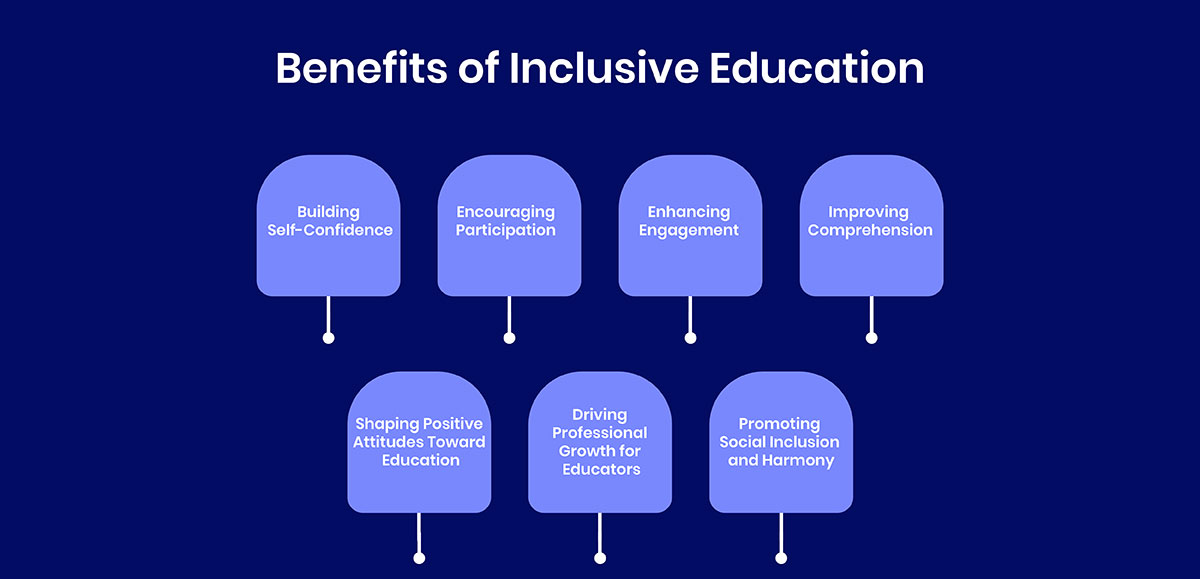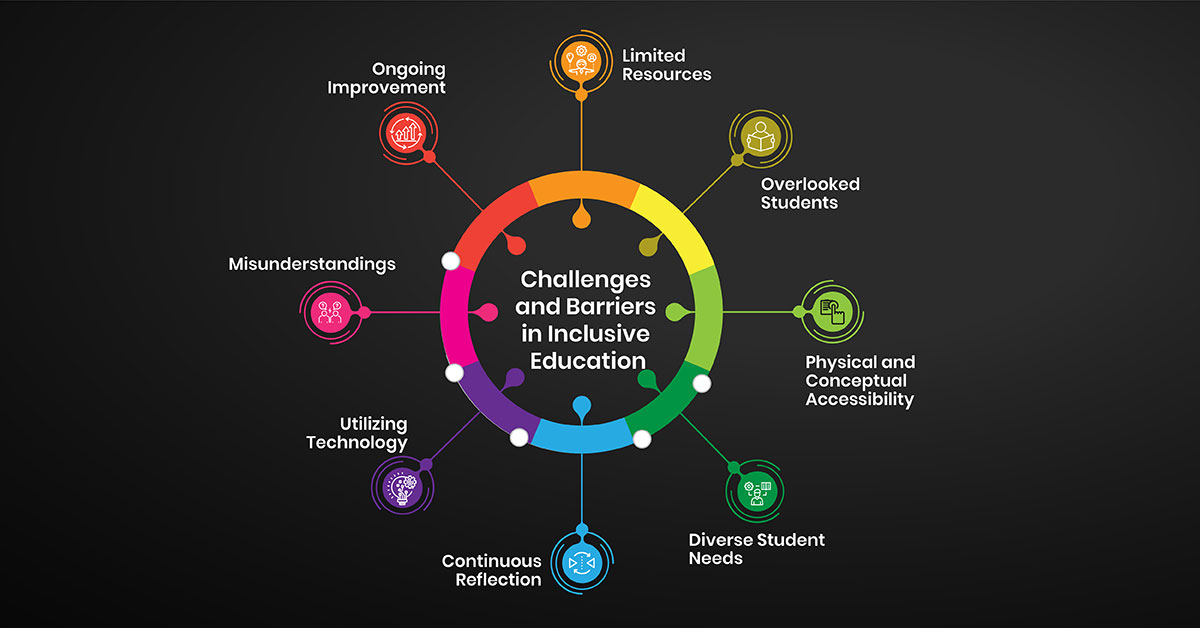Towards Equity: Inclusive Teaching Strategies in Higher Education
February 14, 2025Inclusive education is a vital aspect of modern pedagogy, emphasizing equitable learning opportunities for all students, regardless of their diverse backgrounds or abilities. It goes beyond physical accessibility to address cognitive, emotional, and social dimensions, creating a sense of belonging and empowerment. Rooted in the civil rights movements of the 20th century, the concept has evolved from a "medical model" focused on individual deficits to a "social model" that challenges systemic barriers and celebrates diversity.
Implementing inclusive teaching strategies involves intentional adjustments rather than a complete overhaul of traditional methods. Research-backed principles guide educators in creating environments that accommodate diverse learning styles and develop equity. Small, thoughtful changes in teaching practices can make classrooms more welcoming and dynamic, benefiting both students and educators.
The Essence and Significance of Inclusive Education
Inclusive education is a philosophy and approach that ensures all students, regardless of their abilities, backgrounds, or differences, are valued, supported, and provided equal opportunities to succeed in a shared learning environment. It emphasizes diversity as a strength, fostering a sense of community and belonging while addressing the individual needs of every learner. This approach challenges traditional segregated systems and promotes a collaborative, holistic, and equitable educational landscape.
Several guiding principles shape the implementation of inclusive education. These include respecting diversity by recognizing and appreciating differences, ensuring equitable access to learning opportunities, and building a supportive community where students feel they belong. It also emphasizes student-centered learning, adapting teaching strategies to meet varied needs, and encouraging collaboration among educators, parents, and the broader community to create an environment that nurtures every learner’s potential.
Inclusive education extends beyond accommodating disabilities; it seeks to dismantle barriers that hinder participation and growth. Educators are encouraged to critically evaluate their teaching practices, eliminate biases, and adopt diverse and inclusive materials to support varied learning styles. Inclusive classrooms prepare students for a more equitable society, emphasizing mutual respect and inclusivity as core values. This ongoing commitment to reflection, adaptation, and innovation ensures that education evolves to meet the needs of all students, creating a foundation for a more inclusive future.
Strategies for Creating an Inclusive Classroom
Creating an inclusive classroom is essential for building a learning environment where all students feel valued, supported, and empowered to succeed. By embracing diverse teaching strategies and accommodations, educators can address the unique needs of every student, promoting equity and engagement. The following strategies offer practical approaches to ensure inclusivity in the classroom.
-
1. Differentiated Instruction
Tailor your teaching methods to meet the diverse learning styles and abilities of your students. Use a range of instructional materials, activities, and assessments to address individual needs and ensure that every student can engage with the content in a way that works best for them. -
2. Universal Design for Learning (UDL)
Design lessons that cater to all students by using multiple forms of representation, engagement, and expression. This approach helps to make learning accessible to a wide range of learners, supporting those with various learning needs and preferences. -
3. Collaborative Learning
Build a collaborative environment where students can learn from one another. Encourage peer support and teamwork, allowing students to leverage their individual strengths, enhancing their learning experience while promoting a positive, inclusive classroom culture. -
4. Inclusive Classroom Management
Establish clear, positive behavioral expectations that encourage respect and inclusivity in the classroom. Address classroom challenges with understanding and provide supportive strategies to manage behavior effectively while maintaining an inclusive environment. -
5. Flexible Assessment Strategies
Implement a variety of assessment methods to evaluate students’ understanding. Offer alternative assessments that accommodate diverse learning styles and abilities, allowing students to demonstrate their knowledge in ways that suit their individual strengths. -
6. Accessible Learning Materials
Ensure that all students have access to appropriate learning resources, including textbooks and online materials. Utilize assistive technologies and adapt resources where necessary to meet the needs of students with disabilities or other learning challenges. -
7. Individualized Education Plans (IEPs) and Support Services
Develop and implement IEPs for students who require special education services. Work closely with special education professionals to ensure students receive the targeted support they need to succeed in an inclusive classroom environment. -
8. Encourage a Positive School Culture
Create an environment where diversity and inclusion are celebrated. Organize events and activities that highlight different cultures and experiences, promoting an inclusive atmosphere that values all students. -
9. Inclusive Language and Communication
Use inclusive language that respects all students’ backgrounds and identities. Encourage open communication within the classroom and ensure that all students feel heard, respected, and understood. -
10. Create a Safe Learning Environment
Establish a psychologically safe classroom where students can freely express themselves without fear of judgment. Focus on building mutual respect, empathy, and understanding, ensuring that students feel safe and supported. -
11. Diversify Learning Material
Incorporate diverse perspectives and voices into your curriculum. Include authors, resources, and examples from underrepresented groups to broaden students’ viewpoints and enrich their learning experience. -
12. Account for Student Needs
Adapt your teaching strategies to accommodate the varying needs of your students. This may include offering alternative formats for assignments or assessments, providing extra support, or using assistive technologies to enhance accessibility. -
13. Encourage Participation
Create opportunities for all students to participate in classroom discussions and activities. Be mindful of individual comfort levels and provide tools and strategies that make it easier for everyone to contribute. -
14. Build Rapport with Students
Take the time to get to know your students by learning their names, preferences, and needs. Establish connections through regular interaction, surveys, and activities that make students feel valued and respected. -
15. Set Clear Expectations
Provide students with explicit guidelines, rubrics, and performance criteria. Clearly communicate what is expected of them in terms of academic performance and behavior, so they understand how they will be assessed and what success looks like. -
16. Reflect on Personal Beliefs
Regularly examine your own biases and assumptions to ensure you are helping grow an inclusive teaching approach. Strive for greater self-awareness and make a commitment to equity by adjusting your teaching methods as needed.
Transformative Impact of Inclusive Teaching
Inclusive teaching embraces diverse student needs, creating a supportive environment that ensures equal learning opportunities, active participation, and overall success. Take a look at major benefits of inclusive education:

-
Building Self-Confidence
Inclusive teaching addresses individual challenges by personalizing assessments and learning methods to accommodate diverse needs. This supportive environment helps students overcome fears, such as public speaking or completing assignments, boosting their self-confidence and reducing anxieties. -
Encouraging Participation
When students feel valued and supported, they are more likely to actively participate in classroom activities. An inclusive approach eliminates barriers, creates a judgment-free environment, and ensures that every student feels comfortable sharing their ideas and perspectives. -
Enhancing Engagement
Inclusive teaching brings higher engagement levels by creating a learning atmosphere where students feel connected and involved. Engaged students are more likely to retain knowledge, actively contribute to discussions, and achieve better academic outcomes. -
Improving Comprehension
Specialized teaching strategies and assessment methods help students overcome limitations, such as writing difficulties, test anxiety, or speech impairments. By adapting to individual needs, inclusive education ensures that all students can effectively comprehend and express their knowledge. -
Shaping Positive Attitudes Toward Education
By reflecting diverse experiences in teaching materials and providing equal opportunities, inclusive education develops a positive outlook on learning. Students feel empowered and enjoy their educational journey, viewing it as a source of growth rather than a series of challenges. -
Driving Professional Growth for Educators
Inclusive teaching encourages educators to innovate and adapt their methods to cater to diverse learning styles. This not only enhances their professional development but also deepens their satisfaction as they see all students thrive in a supportive environment. -
Promoting Social Inclusion and Harmony
Beyond the classroom, inclusive education cultivates empathy, mutual respect, and a sense of community. It breaks down stereotypes, improves understanding, and lays the foundation for a more inclusive and equitable society.
Overcoming Challenges and Barriers in Inclusive Education
Inclusive education aims to create a learning environment that accommodates the diverse needs of all students. However, it faces several challenges that require strategic approaches to ensure every learner has equal opportunities to succeed.

- Limited Resources: Large class sizes and insufficient resources make it challenging for educators to meet the diverse needs of students.
- Overlooked Students: Despite best efforts, some students may be unintentionally overlooked due to systemic limitations in support and infrastructure.
- Physical and Conceptual Accessibility: Inclusion goes beyond policies; it involves ensuring both physical spaces and learning materials are accessible to all students.
- Diverse Student Needs: Educators must consider cultural, linguistic, neurological, and ability-related differences when designing learning experiences.
- Continuous Reflection: Regular evaluation of how accessible the learning environment and resources are helps maintain an inclusive atmosphere.
- Utilizing Technology: Leveraging technology and differentiated instruction on time and need-specific is necessary to help address various learning styles and needs.
- Misunderstandings: Many misconceptions about inclusive education stem from a lack of understanding, such as the belief that it only benefits students with disabilities or slows down others.
- Ongoing Improvement: Addressing these challenges requires continuous professional development for educators, stronger policies, and consistent efforts to improve accessibility.
Conclusion
Inclusive education is essential for creating a learning environment where all students, regardless of their backgrounds or abilities, can thrive. By implementing strategies that address diverse needs, educators cultivate an atmosphere of respect, collaboration, and equal opportunity. While challenges exist, the benefits of inclusivity—such as increased engagement, self-confidence, and social harmony—are clear. With continued investment in inclusive practices, educational institutions can ensure that every student has the support they need to succeed, contributing to a more equitable and compassionate society.




